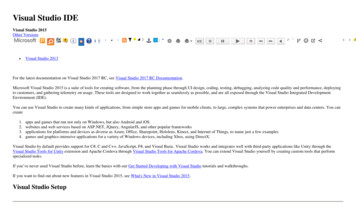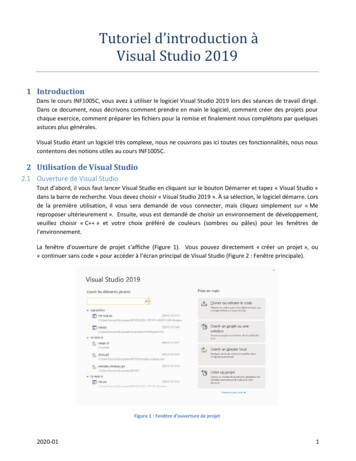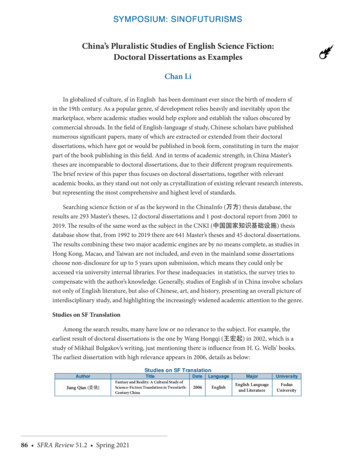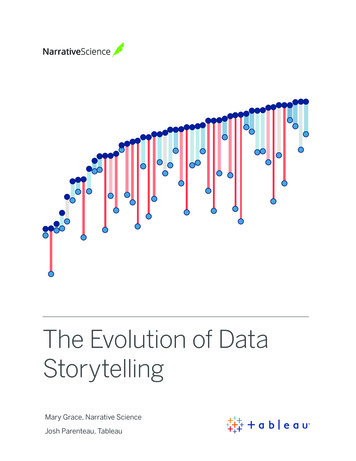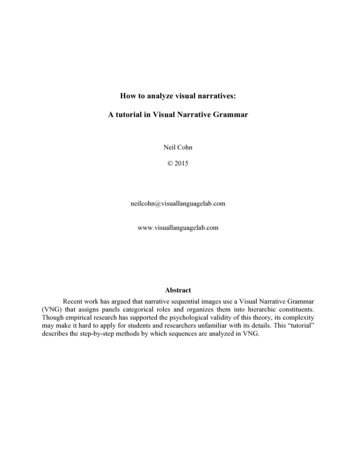
Transcription
How to analyze visual narratives:A tutorial in Visual Narrative GrammarNeil Cohn gelab.comAbstractRecent work has argued that narrative sequential images use a Visual Narrative Grammar(VNG) that assigns panels categorical roles and organizes them into hierarchic constituents.Though empirical research has supported the psychological validity of this theory, its complexitymay make it hard to apply for students and researchers unfamiliar with its details. This “tutorial”describes the step-by-step methods by which sequences are analyzed in VNG.
Applying the theory of Visual Narrative Grammar2IntroductionThis supplement is designed to help students and researchers analyze comics andsequential images using the theory of Visual Narrative Grammar (VNG). This theory argues thatpanels become categorized into specific types, and that there may be hierarchic groupings ofpanels into constituents. For example, below is the hypothesized structure for a sequence fromTym Godek’s One Night:This sequence starts with an Establisher which sets up the scene, and then progresses toan Initial which starts the main actions: the man is thinking in bed. The Peak of the sequence—its climax or primary information—occurs in a constituent of two panels. In this case the Peakconstituent shows the man’s contemplation of whether to get out of bed (an Initial) and take ashower (a Peak). The final panel is a Release, the resolution or aftermath, with the man decidingnot to get out of bed. This sequence illustrates several of the primary features of VNG: Eachpanel has a narrative category, and panels can combine to form groupings that also havecategories.This “tutorial” aims to help explain how an analyst might identify these elements whenexamining a sequence. Because this document is aimed at application, I will not describe thebasic principles of VNG any further than the above example. For this, I refer the reader to mybook, The Visual Language of Comics (Cohn, 2013b), and to my papers on the topic (Cohn,2013c, 2015b). The methods described here should help instruct how to analyze the properties ofVNG in visual sequences, and they emerge from the underlying logic of the system.Diagnostic testsBefore jumping into how we do analyses, it should be noted that not all sequences ofimages use the principles of VNG. In particular, narrative sequences used in multimodal contexts(i.e., combining text and image) may not have a clear-cut narrative structure, due to the meaningbeing distributed into both text and image. If the text conveys as much if not more meaning thanthe visuals, it may be likely that the visuals do not actually use this narrative grammar. The
Applying the theory of Visual Narrative Grammar3structures of VNG appear most strongly in wordless visual narratives. A simple test can sufficehere: If you can delete the visuals and retain the overall gist of the sequence, the visuals may notuse a narrative grammar. If you can delete the text and the visuals retain their overall gist, thevisuals likely do use a narrative grammar. For more on this, see Cohn (2015a).Now let’s discuss how to analyze sequences. Importantly, applying VNG is not a matterof looking at a sequence and assigning categories/constituents to it. This may be a decentstarting point, but actual analyses should make use of diagnostic tests that reveal the structure ofthe sequence. While intuitions are used at each stage of these diagnostic tests, tests provide amethodology beyond merely looking at a sequence and labeling things. These diagnostics canalso extend beyond the contexts of analyzing a given sequence, and can be used as the basis forpsychological experimentation (and indeed, many already have).Diagnostic tests manipulate a sequence of images in order to reveal its structure. Thesemanipulations are based on methods developed over decades from linguistics (e.g., Cheng &Corver, 2013), and also draw on the underlying logic of the system itself. In many cases,diagnostics are supported by empirical evidence from psychology experiments. Diagnostics cantest for the categories of particular panels and the groupings of those panels into constituents.Additional diagnostics apply to other modifiers in VNG, such as conjunction, Refiners, andPerspective Shifts, for which the reader is referred to specific publications (e.g., Cohn, 2015b).Most diagnostic tests involve manipulating a panel or sequence through deletion ofpanels, rearranging panels, or substituting panels for other elements. These methods are spelledout in the appendix at the end, along with the results that should occur when these tests appliedto categories and constituents. For now, we’ll jump right into the order that tests are applied andthen a sample analysis.Order of operationsWhen analyzing a sequence of images, you should use an “order of operations” forapplying intuitions and diagnostic tests. The order described here is what has worked so far, butother methods are conceivable if justified.1) Categories before constituents – The categorical status of individual panels is easier todetermine than the breakdown of whole constituents (which also may hinge on the categoriesinside them). So, identify the panels’ categorical roles before attempting to identify thesegmentation of the constituents.1.1) Find the Peak(s) – Because a sequence hinges on the information in the Peak, they shouldbe the first thing(s) to be identified in a sequence. The following steps should be used:a. Semantic intuitions – A good first step is to use your intuitions for what sort ofinformation panels convey. Peaks contain primary actions and often have the“climax” of a sequence. You can treat this identification of panel(s) as a “hypothesis”for which panels may be Peaks.b. Action Star Substitution – Now test those hypotheses by replacing those positedPeak panels for action star panels. Can they be replaced and still make sense? If so,they may be Peaks.
Applying the theory of Visual Narrative Grammar4c. Deletion – A second test may use deletion. Try omitting those panels you thoughtwere Peaks. Does the sequence still make sense? Does it force you to infer a lot ofinformation? If so, they may be Peaks.1.2) Find Initials and Releases – Now that you have identified the Peaks, it is best to identifypanels supporting those Peaks. Initials and Releases are the next most important panels in asequence, and are often adjacent to Peaks.a. Semantic intuitions – Again, starting with your intuitions about the content of asequence is a good first step. Initial panels often show preparatory information, whileReleases show resolutions or aftermaths. Instead of basing this on content alone, youmight also think about what is happening relative to the Peaks you’ve already found:Does a panel preceding a Peak lead up to it (Initial)? Does a panel following the Peakprovide an aftermath or resolution to it (Release)?b. Deletion – A deletion test can be a good follow up here. If a panel preceding a Peak isdeleted and makes it feels like the Peak is suddenly more abrupt, it is likely an Initial.If a panel following the Peak is deleted and makes it feels like the sequence is “lefthanging,” it may be a Release.c. Modification – You may also want to try a “Jeez, what a jerk!”-test for Releases. Canthis phrase be added in a balloon to the panel? Maybe it’s a Release then.1.3) Find Establishers and Prolongations – Establishers and Prolongations are often the leastnecessary of all categories, and so they can be identified last.a. Semantic intuitions – Again, a good starting hypothesis can use intuitions about thesemantics of a panel or its relations to other images. Does the panel “set up” thesituation without providing any actions? Are characters introduced to each other inthe panel? If so, it may be an Establisher. Is a panel preceding a Peak but followingan Initial? Does it only show the extension of a path (like only a ball sailing throughthe air)? If so, it may be a Prolongation.b. Deletion – Both Establishers and Prolongations can both be omitted from a sequencewithout affecting its understanding. If your hypothesized panels can be deleted withlittle impact on the sequence, they may be Establishers or Prolongations.c. Reordering – Another test you can do is to move your hypothesized Establisher to theend of the sequence or to swap it with a Release. Is the narrative still comprehensible(even if the meaning changes)? This may be an Establisher then.d. Framing – Can the panel be incorporated into the content of the prior Initial panel viaa motion line? If so, that panel could be a Prolongation.2) Identify constituents – Now that you have hypotheses about the narrative categories, you canbegin to identify the constituents. Here are some good ways to do this:a. Semantic intuitions – Like in identifying categories, recognizing where boundariesstart and stop between constituents can begin by looking at the meaningful relationsbetween images. For example, breaks between constituents often have changes incharacters or locations, or start a new set of actions. If you can identify the place thatthis occurs (perhaps also starting with a new Establisher), you can find the breakbetween groupings.
Applying the theory of Visual Narrative Grammar5b. Grammatical patterns – Another way to hypothesize about constituents is to look atthe sequencing patterns that are left by your analysis of narrative categories. Thecanonical narrative phase uses a sequence of E-I-L-P-R. Thus, constituents may beformed by any categories in your analyzed strip that go in that order (or shortersubsets of that order, like I-P or I-P-R). If you find places that do not go in that order,it may be places where there is a break between constituents (ex. I-P-E , P-R-I ,P-R-R, etc.).c. Deletion test – A good first test is, again, to try to delete constituents. If you candelete a whole span of panels, it may be a constituent. Deletion of panels that “leavesbehind” some weird sequencing may be the deletion of only part of a constituent, ormay possibly delete across the boundary of multiple constituents.d. Reordering – Now try rearranging those groupings of panels in the sequence. Canyou move a whole group for another group? Maybe those panels form constituents.e. Sliding Window – Finally, try analyzing the sequence using a sliding window. Awindowed grouping of panels that form a constituent, or part of a constituent, shouldbe identifiable as a coherent sequence. Windowed panels that do not form aconstituent may be harder to understand. You can then line up your analyses to seewhich panels consistently are harder to understand, and the boundary betweenconstituents should appear. For example, consider this simple dataset:Good: 1-2-3Bad:2-3-4Bad:3-4-5Good:4-5-6Each of these lines represents a selection from a 6-panel sequence where each“windowed segment” includes only three panels. The first and last segments areconsidered to be understandable, while the middle segments are considered lessunderstandable. The only string that appears in both of the “less understandablesegments”, while not appearing in the “understandable segments”, is only the string of3-4 (bold and underlined). We might hypothesize that this is where the boundarybetween segments lies: between these panels. Thus, we might posit that this sequencehas a segmentation of: [1-2-3]-[4-5-6]This order of operations can be applied to sequences of images under analysis. Note that theseinstructions have so far been applied only to “normal” sequences with only simple categoricalsequencing. If a sequence uses modifiers like conjunction or Refiners, the analysis may becomemore complicated. See Cohn (2015b) for details on diagnostic tests for those elements.Sample AnalysisWith our order of operations now in place, let’s illustrate how this works with an actualexample. Here, we’ll use a Sunday Peanuts strip, since it has fairly clean depictions, a goodnumber of panels, and a well-defined start and end. VNG can apply to sequences within longform visual narratives as well (such as comic books, manga, graphic novels, etc.), thoughdiscrimination of the boundaries of those sub-sequences would need to be found. This can follow
Applying the theory of Visual Narrative Grammar6the same types of criteria described above. However, for simplicity, we will use an isolatedsequence.First, here is the sequence as a whole, as it appears in its original layout. This sequenceshows the Peanuts gang playing baseball. Lucy throws a beat-up baseball to Charlie Brown, whohits it, and while running the bases gets whopped by Lucy and the beat-up ball.In order to better apply our analysis to this sequence, we will often change the page layout to alinear sequence. This is not a fully required step, since VNG applies to the content of the images,not to their physical arrangement (which would be their “external compositional structure”—seeCohn (2013a)). One could alternatively number each panel in this original strip, and then label alinear sequence of just those numbers too. Using a linear sequence makes things easier to seethough, so we’ll use that method.Step 1: Identify categories - As stated before, our first step is to identify the narrative categories.We can start by using our intuitions, based on the semantics of each panel.1.1. We should start by finding the Peaks. Let’s do this first by asking which panels might showcompleted actions or “climactic” events. I’ve highlighted several of these actions within variouspanels of the sequence (the “morphological cues” relevant for the narrative structures), whichappear in panels 2, 4, and 7. We can treat this as a hypothesis for which panels are Peaks.
Applying the theory of Visual Narrative Grammar7We can now see if our assumptions are correct by doing a few diagnostic tests. First let’stry an action star substitution. Replacing an action star for each of our hypothesized Peaksrenders the sequences fairly understandable. Here’s the first one:That seems decent at least, though there’s maybe a little ambiguity. There may be good reasonfor that, which we’ll go into later on. Here’s the second one:
Applying the theory of Visual Narrative Grammar8I think this one works much better. We actually had a cue that it might work, since the originalpanel uses an “impact star” to show where the ball hits the bat, and the action star is basically ablown up version of this. And here’s the third one:This one again seems pretty good. The action star here again replaces an impact. So, our findingsfor the action star substitution tests are that we have two Peaks that replace well (panels 4 and 7)and one that works so-so (panel 2). Just for contrast, here’s what happens when we try to swapout the the action star for a panel that we didn’t hypothesize as being a Peak:
Applying the theory of Visual Narrative Grammar9Notice that this sequence might seem harder to understand. That gives us a clue that thispanel is not a Peak, because it fails the “action star substitution” diagnostic. We now have onepiece of support that these panels are Peaks. Let’s do another diagnostic just to make sure. Here,let’s try a deletion test. The sequence should be fairly bad if Peaks are deleted. I’m going to justdelete one of them, and I’ll let you imagine what it would be like to delete the others (you canjust hold up your fingers over the sequence to block out other panels):Here, I’ve deleted panel 7, the penultimate panel. The resulting sequence is a littlestrange, and seems to end fairly abruptly. Notice that there might seem like a lack of a real“climax” here. That sense is the lack of the Peak. For a long sequence like this, we can do a finaltest on the Peaks, by trying to paraphrase the sequence using only the hypothesized Peak panels:
Applying the theory of Visual Narrative Grammar10This sequence seems pretty understandable, and provides a more compact version of essentiallythe same narrative. Compare this to a paraphrase of panels that are not hypothesized as beingPeaks:This sequence seems much less able to summarize the original strip, especially in comparison tothe prior paraphrase. This is a strong additional clue that the panels in the first paraphrase arePeaks.1.2 Now that we have our most important panels identified (Peaks), let’s turn to identifying thenext most informative: Initials. Again, we can first use our intuitions, since Initials arecanonically preparatory actions. This gives us these highlighted panels:Conveniently, most of these panels show up prior to our Peak panels, so that’s a goodhint that they are Initials. We know this because Initials often precede Peaks in the canonicalnarrative arc. Notice that the second panel, which we already said might be a Peak, also has ahighlight of the ball. This is the case because this information provides the “source” (startingpoint) of a path—another semantic feature of Initials. Can this panel be both a Peak and anInitial? Is this why the action star substitution was a little less good? We’re going to leave theseboth as hypotheses right now, and come back to it later.We should now do a test to see if these are Initial panels. Again, a deletion test mighthelp. Deletion of an Initial should make a sequence somewhat harder to understand, but it shouldbe better than deleting a Peak. For brevity, I’ll let you apply these tests on your own.
Applying the theory of Visual Narrative Grammar111.3. The next step would be to identify the other categories: Establishers, Prolongations, andReleases. An Establisher would typically set up the relations between the characters, while aRelease would provide an aftermath or resolution to the sequence. These should be a little lessimportant if deleted. We only have two panels left to be analyzed (panels 5 and 8), and bothseem to be deletable.Panel 5 contextually precedes an Initial but follows a Peak. But, its events seem to start(ahem establish) a new situation, which means it seems more like an Establisher for the Initialthan a Release for the prior Peak. Also, the final panel follows a Peak, like we’d expect for aRelease, and it can also pass the “Jeez, what a jerk!” test. Try replacing that dialogue for CharlieBrown’s in the final panel: It works pretty good! That’s a clue that it is a Release.We now have assigned categories to all the panels in the sequence. Our analysis lookslike this:Step 2: Identify the constituents – Now that we have our surface categories, we can try toidentify which panels group together in constituents. A first clue comes from our categories: Weknow that the canonical narrative arc goes Establisher-Initial-Peak-Release, so segments thatretain this pattern should go together. This groups together panels 1 & 2, and 3 & 4 (both“Initial-Peak” segments) and the final four panels, which maintain a whole narrative arc.This is further supported by the semantics that divide these hypothesized segments.Between panels 2 and 3, the characters change (from Lucy to Charlie) and between panels 4 and5, they change in actions (Charlie hitting vs. running) and in characters (Lucy is added back in).These changes often align with the breaks between constituents, and thus give us a clue about thegroupings.With these hypotheses, let’s do a few diagnostics, starting with a deletion test. It shouldbe better for us to delete whole constituents than it would to delete across the boundary betweenthem. Let’s try this by deleting all of our hypothesized whole constituents:
Applying the theory of Visual Narrative Grammar12I’ve drawn red lines here to show where the constituents were deleted. Sequence (a)deletes the whole final constituent. Sequence (b) deletes only the first one, (c) deletes the middleone, and (d) deletes both of these. In each of these cases, the sequence stays fairlycomprehensible. My interpretation would say that the worst among these is (c), where the lack ofCharlie hitting the ball leaves a lot to be inferred. Compare this to sequences where the deletionscross over the constituent boundaries. Here, I’ve deleted two panels on either side of the breakbetween hypothesized constituents:These sequences in (e) and (f) should feel a bit worse than the ones in (a-d). Personally, Ithink sequence (f) is a bit less coherent than (e) also. This might come into play a little later, andis connected to why (c) above may be a little less good than the other deletions in (a-d).Let’s now try another test by using the sliding window. Here, I’ve selected a slidingwindow of three panels long, where each three-panel chunk throughout the sequence is selected.Here they are:
Applying the theory of Visual Narrative Grammar13Here, we want to treat each segment as if it was a whole, isolated sequence. We can thenassess the comprehensibility of each sequence. To me, (g) seems a little weird on its own, likeit’s leaving something hanging. I get the same feeling from (i) and (j)—all of them feel likesomething is left unresolved (and (j) feels like it starts a bit suddenly). The other sequences—(h),(k), and (l)—feel better, like more of a whole coherent message unto each one. However, (h) and(k) lack a resolution, and (l) starts a bit suddenly. They don’t feel like anything substantial ismissing though.This leaves us with these assessments that line up like this:
Applying the theory of Visual Narrative Grammar14Here, I’ve spaced out the segments so that they line up all the panels in the sequence. I’vemarked the ones that are a little “weird” with an “X”, and I’ve also put red lines to show whereour hypothesized boundaries between constituents are. Notice that all of the ones that weredeemed a little “weird” have a constituent break running through the middle of them. The onlyexception is (h), where the constituent break divides the first two panels, but this sequence wasnot overly bad. This again relates to our analysis of (c) and (e) in the deleted constituents above,which we’ll tackle next.Altogether, this analysis gives us three major groupings. Here are our groupings, withdouble lines indicating the Peaks, which are the “head” of each grouping (as we tested with ourparaphrasing):Now we might want to ask: what are the relationships between these groupings, and arethere any higher-level groupings? We essentially have three options of groupings (with eachnumber being a constituent):1) [ 1 – 2 – 3 ]2) [[ 1 – 2 ] – 3 ]
Applying the theory of Visual Narrative Grammar153) [ 1 – [ 2 – 3 ]]The most straightforward option would be the first, with each constituent standing aloneand playing a role in a larger narrative arc. However, there have been a few pieces of evidencethat might suggest against this. First, we had some in-between intuitions in deletion tests (c) and(e) and the sliding window in (h). Second, we had the dual categories on panel 2 (Initial andPeak?). Let’s consider these points in depth.First, we saw in the deletion test (c) that deleting the middle constituent didn’t make asmuch sense as deleting the other ones. This implies that the second constituent (panels 3&4) isperhaps more important as a constituent than the first constituent. We also saw that deletingacross the boundaries of this constituent was a little better than deleting across the subsequentconstituent boundaries. Here, we deleted panel 4 (a Peak) and 5 (an Establisher). If thisconstituent is more important, then deletion of its Peak (panel 4) should indeed make it harder tounderstand, and leaves the constituent hanging with an Initial (panel 3). This is different thandeleting across the first boundary (omitting panels 2 and 3), which keeps this motivating Peak,which now can just fuse with the Initial in the first panel to form another coherent constituent.Finally, let’s consider our earlier observation that panel 2 has features of both a Peak andan Initial. We know that the panel plays a role as a Peak compared to its prior Initial, since thatforms a coherent Initial-Peak constituent. But, the extra semantic features may mean that thiswhole grouping plays a role as an Initial.So, all of this may point to the first and second constituents connecting to each other. Thesecond panel plays a role as a Peak in relation to the prior Initial, but the semantic featuresrelated to a source of a path also relate to an Initial. This information is only relevant as an Initialfor subsequent information, such as in the next constituent. The first two groupings may form aneven larger constituent, with the first grouping playing a role as an Initial (motivated by thesemantic features in the second panel), and the second grouping playing a role as a Peak:At this point we’re almost done. We just need to figure out the overall relationship of thislarger grouping to the subsequent grouping. There are now just two of our options left: we caneither link the final constituent into the same grouping as the Initial and Peak constituents (option#1) or we can create another, larger constituent that links together the remaining structures(option #2).
Applying the theory of Visual Narrative Grammar16We can go back to our original deletions for a clue: deletion of the final Peak shouldseem more impactful than deleting the middle Peak, a clue that this final Peak is the “mainclimax” of the sequence. This might tell us that the first grouping is another Initial in relation tothe final four panels, which are the primary Peak (option #2). If we were to connect this finalconstituent to the existing structure, it would have to play the role of a Release. This is because aRelease is the only possible category that can follow a Peak within this higher-level structure,which already has an Initial-Peak ordering. Because the final sequence seems to be the “mainclimax” and not a resolution, it appears that option #2 makes more sense:There we have it! The whole sequence is now analyzed, derived from the diagnostic testsin combination with our intuitive judgments. It’s worth making a final note: The Release panel atthe very end is technically ambiguous here, since it is preceded by a Peak locally (within theconstituent) and also at a higher level (the Peak constituent). It could hypothetically attach toeither the Peak constituent or the Arc, to follow either one of these Peaks. This ambiguity issupported by the fact that it could also be included in a paraphrase with only the Peak panels(motivating each of the top-most constituents), and in the grouping of only the final constituent(as in (d) from the deletion test). Such ambiguity is intrinsic to the grammatical system. Thisambiguity could be resolved though. If we inserted another panel before the final one (say,Charlie walking to the bench), this would create a new constituent, with this grouping playingthe Release role that connects to the Arc, not within the Peak constituent.Final remarksHopefully this tutorial has been helpful for you to understand how Visual NarrativeGrammar is implemented, and hopefully also to understand some of its underlying logic. It is notmerely a matter of looking at an image sequence, assigning categories, and drawing linesbetween them. Rather, there is a systematic process that uses explicit diagnostic tests at eachstage. Like any skill, this type of analysis requires practice. Over time, it is possible to more
Applying the theory of Visual Narrative Grammar17quickly and easily assess the properties of a sequence, and the application of diagnostic tests canbe done in your head (assuming you have the fluency to do so).Finally, though it may have seemed like a trek to complete it, the sequence that weanalyzed here is actually quite simple. Yet, much more complexity arises in different types ofvisual narratives, which use various complex modifiers and constructional patterns (Cohn,2015b). Further publications about Visual Narrative Grammar will detail these components alongwith the necessary diagnostic tests to analyze them.Appendix: Diagnostic testsIndividual categoriesBelow are descriptions of how diagnostic tests are expected to behave for each particularnarrative category, in order of the importance of the category to the narrative arc (Cohn, 2014):Peaks – Peaks are the most important category of a narrative sequence, and the rest of thesequence most often “hangs” around the content in the Peak.- Deletion – A sequence should be rendered harder to understand by the deletion ofthe Peak. Its deletion should create the need for a great deal of inference.- Paraphrasing – Because a sequence “hangs off” of the Peaks, deletion of all nonPeak categories can often provide a truncated “paraphrase” of the sequence.- Reordering – Peaks do not fall in complementary distribution with othercategories. Thus, moving a Peak to other positions within a sequence should makethat sequence harder to understand.- Substitution – Peaks are the most capable of being substituted by “suppletivepanels” (Cohn, 2013b), the most informative being an action star (Cohn &Wittenberg, 2015). If a panel can be effectively replaced by an action star andretain the sense of narrative (though the semantics may become less informative),the substituted panel is likely to be a Peak. If the substitution of an action star fora panel creates a less coherent sequence, it is likely that panel is not a Peak.Initials – Initials are the second most informative category for a narrative sequence, andthus also have fairly restrictive usage.- Deletion – A sequence should be rendered harder to understand by the deletion ofthe Initial. Its deletion should create a sense of a sudden jump into a Peak.- Reordering – Initials do not fall in complementary distribution with othercategories. Thus, moving an Initial to other positions within a sequence shouldmake that sequence harder to understand.Releases – Releases are also fairly informative, but often less semantically necessary thanPeaks or Initials.- Deletion – A sequence can stay fai
Applying the theory of Visual Narrative Grammar 3 structures of VNG appear most strongly in wordless visual narratives. A simple test can suffice here: If you can delete the visuals and retain the overall gist of the sequence, the visuals may not use a narrative grammar. If you can delete the text and the visuals retain their overall gist, the




